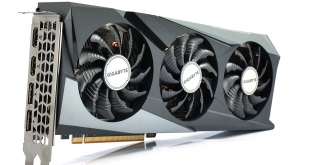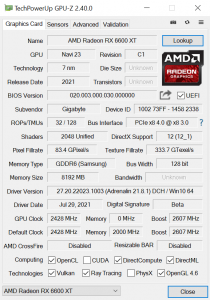
Today marks AMD's first GPU launch for five months, with the company unleashing its new RX 6600 XT. Designed to offer the ultimate 1080p gaming experience, AMD claims the RX 6600 XT has the beating of Nvidia's RTX 3060, and accordingly has set pricing higher at $379 MSRP. We put this card through its paces and compare it to a wide range of both current and former-generation GPUs.
The first three RDNA 2-based GPUs – the RX 6900 XT, RX 6800 XT and RX 6800 – all used Navi 21 silicon, while the RX 6700 XT made use of Navi 22. Now, with the new RX 6600 XT, AMD has introduced Navi 23, its smallest RDNA 2-based GPU yet, measuring just 237 mm². While this reduces the number of Compute Units, stream processors, ray accelerators and so on, it's also interesting to see AMD opt for a 128-bit memory interface.
That allows the company to comfortably pair the GPU with 8GB of memory – avoiding the situation as seen with the RTX 3060, where Nvidia's mid-range GPU has more VRAM than even the RTX 3080. It is, however, a relatively narrow bus for a GPU of this price class, and while AMD has its Infinity Cache to fall back on, there's only 32MB of it here, compared to 96MB on the RX 6700 XT.
That may be why AMD chose to focus the 6600 XT solely on 1080p gaming, a resolution where the GPU is less likely to be constrained by memory bandwidth than at 1440p. We will, however, be testing this GPU across 1080p, 1440p and even 4K resolutions throughout this review.
It is also worth making clear that the RX 6600 XT is an ‘AIB-only' launch, meaning there's no AMD reference card. For this review, AMD sampled us directly with a Gigabyte RX 6600 XT Gaming OC Pro 8G, Gigabyte's flagship 6600 XT offering.
| RX 6900 XT | RX 6800 XT | RX 6800 | RX 6700 XT | RX 6600 XT | |
| Architecture | RDNA 2 | RDNA 2 | RDNA 2 | RDNA 2 | RDNA 2 |
| Manufacturing Process | 7nm | 7nm | 7nm | 7nm | 7nm |
| Transistor Count | 26.8 billion | 26.8 billion | 26.8 billion | 17.2 billion | 11.1 billion |
| Die Size | 519 mm² | 519 mm² | 519 mm² | 336 mm² | 237 mm² |
| Ray Accelerators | 80 | 72 | 60 | 40 | 32 |
| Compute Units | 80 | 72 | 60 | 40 | 32 |
| Stream Processors | 5120 | 4608 | 3840 | 2560 | 2048 |
| Game GPU Clock | Up to 2015MHz | Up to 2015MHz | Up to 1815MHz | Up to 2424MHz | Up to 2359MHz |
| Boost GPU Clock | Up to 2250MHz | Up to 2250MHz | Up to 2105MHz | Up to 2581MHz | Up to 2589MHz |
| Peak SP Performance | Up to 23.04 TFLOPS | Up to 20.74 TFLOPS | Up to 16.17 TFLOPS | Up to 13.21 TFLOPS | Up to 10.6 TFLOPS |
| Peak Half Precision Performance | Up to 46.08 TFLOPS | Up to 41.47 TFLOPS | Up to 32.33 TFLOPS | Up to 26.43 TFLOPS | Up to 21.21 TFLOPS |
| Peak Texture Fill-Rate | Up to 720 GT/s | Up to 648.0 GT/s | Up to 505.2 GT/s | Up to 413.0 GT/s | Up to 331.4 GT/s |
| ROPs | 128 | 128 | 96 | 64 | 64 |
| Peak Pixel Fill-Rate | Up to 288.0 GP/s | Up to 288.0 GP/s | Up to 202.1 GP/s | Up to 165.2 GP/s | Up to 165.7 GP/s |
| AMD Infinity Cache | 128MB | 128MB | 128MB | 96MB | 32MB |
| Memory | 16GB GDDR6 | 16GB GDDR6 | 16GB GDDR6 | 12GB GDDR6 | 8GB GDDR6 |
| Memory Bandwidth | 512 GB/s | 512 GB/s | 512 GB/s | 384 GB/s | 256 GB/s |
| Memory Interface | 256-bit | 256-bit | 256-bit | 192-bit | 128-bit |
| Board Power | 300W | 300W | 250W | 230W | 160W |
As a spec recap, RX 6600 XT is built using the new Navi 23 GPU, a physically small die, measuring just 237 mm². It houses 32 Compute Units (CUs), with 64 stream processors per CU, giving a total of 2048. RX 6600 XT features a fully populated Navi 23 GPU, but we can expect a cut-down version to appear with the rumoured RX 6600.
RDNA 2 houses one ray accelerator per CU, so there’s a total of 32 with the RX 6600 XT. Four texture units per CU gives a total of 128, while there’s also 64 ROPs. Clock speed remains at the lofty heights that we saw from the RX 6700 XT, as the 6600 XT's rated game clock of 2589MHz is 8MHz above that of the RX 6700 XT.
As for the memory configuration, AMD has opted to use a 128-bit memory interface paired with 8GB of GDDR6 memory. Using 16Gbps modules, total memory bandwidth hits 256 GB/s, lower than even the last-generation RX 5600 XT . RDNA 2 GPUs, however, have the benefit of AMD’s Infinity Cache, but even that is reduced, with just a 32MB cache used here.
Lastly, total board power (TBP) is rated at 160W, a reduction of 70W, or almost 30%, compared to the RX 6700 XT. We are using our new GPU power testing methodology in this review, so read on for our most detailed power and efficiency testing yet.
 KitGuru KitGuru.net – Tech News | Hardware News | Hardware Reviews | IOS | Mobile | Gaming | Graphics Cards
KitGuru KitGuru.net – Tech News | Hardware News | Hardware Reviews | IOS | Mobile | Gaming | Graphics Cards




